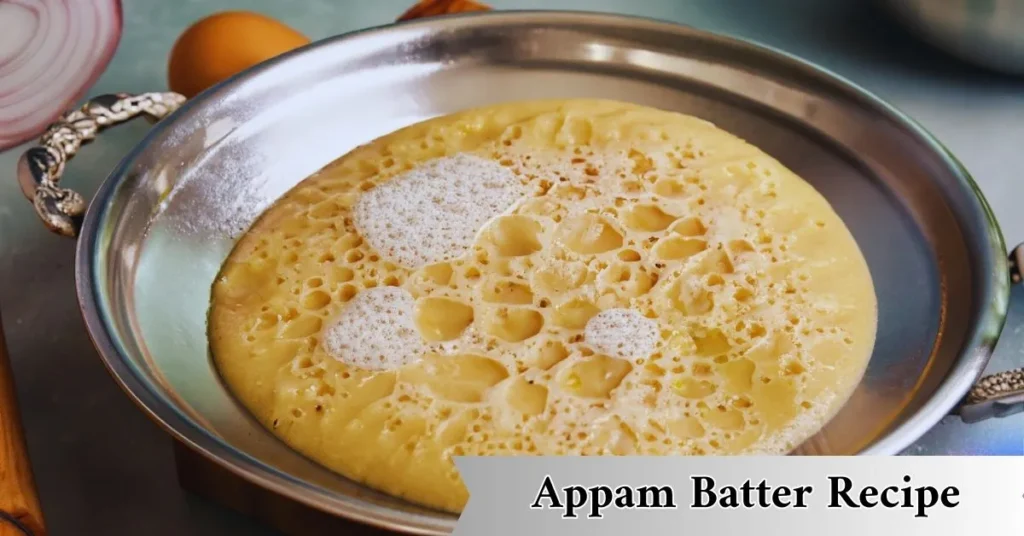Greetings to the charming world of South Indian food! In South India, “Appam Batter Recipe” holds a special place in people’s hearts, thanks to its light, fluffy texture and crisp edges, making it a savory sidekick for many breakfast choices. Learn how to create the ideal batter for appams in the convenience of your own space with our help.
Understanding Appam Batter Recipe: A Brief Introduction
Appam, also known as “Vellayappam” in some regions, is a traditional South Indian pancake made from fermented rice and coconut batter. Idli is a celebrated breakfast dish in these two Indian states and is frequently served during special events. The novel form and surface of the appams distinguish them from other pancake varieties. The core of the Appam Batter Recipe is puffed up with ample sweetness, while the periphery is crisp and wafer-thin.
Ingredients You’ll Need: Preparing the Essentials
You’ll need the following ingredients to make the perfect Appam Batter Recipe.
Raw Rice: Go for excellent-quality polished rice, Kerala Matta rice, or another brief-grain selection.
Grated Coconut: Both freshly grated and frozen coconut can be utilized, with comparable outcomes.
Cooked Rice: Certain formulas require pre-cooked rice because it facilitates fermentation.
Fenugreek Seeds: These add a unique flavor and help with fermentation.
Sugar: Sugar plays a tiny role in the fermentation procedure.
Yeast (Optional): While many classic dishes involve yeast, you may replace it with a naturally fermented batter.
Salt: Appams can benefit from improved flavors.
The Process of Soaking and Grinding: A Great Bat’s Secret to Victory
Initially, carefully clean the uncooked rice before soaking it in water for approximately 4 to 6 hours. Furthermore, combine the fenugreek seeds with the cooked rice. Blend the soaked mixture with enough water to create a thick, smooth paste once the excess liquid has been removed. Select from either conventional or cutting-edge tools, depending on preference. A precise consistency in the batter yields the perfect texture for appams.
Fermentation: Allowing the Magic to Happen
Transfer the ground substance to an enormous bowl afterward. Dissolving yeast in warm water before combining it with other components is essential. Combine and then cover with a clean cloth. Give the batter sufficient time to ferment, allowing it to mature for at least 8 hours or overnight. The fermentation process produces an infinitesimal tanginess, making the Appam Batter Recipe soft and ethereal.
Addition of Coconut Milk: The Secret to Creaminess
After allowing the batter to mature, adding coconut milk infuses depth of flavor. The fresh coconut milk intensifies the appeal and richness of the appams. Blend the grated coconut, cooked rice, and batter for a smooth mixture. Add a little water or coconut milk to adjust its texture when the batter is too dense.
Perfecting the Consistency: Achieving the Right Texture
The texture of appams depends significantly on the evenness of their batter. Strive for a balance between thin and thick when preparing the beverage, and simply pouring the batter onto the pan results in a smooth, flowing pattern. Sample a small batch of appams to gauge and adjust their cohesiveness.
The Art of Making Appams: Cooking Techniques Unveiled
It’s impossible to cook authentic appams without an “appachatti” or appam pan. Gently coat the pan with oil or ghee and cook it over medium heat. Add a spoonful of batter to the pan’s middle and circle-rotate the pan to distribute the mixture evenly. Once the pan is covered with a lid, cook the appams over low heat until the rim turns golden brown, and the interior becomes light and airy.
Serving Suggestions:
Pairing Appams with Delicious Accompaniments
Appams pair exceptionally well with a diverse range of accompaniments. Some popular accompaniments include:
● Coconut Milk Stew: Coconut milk-based stew boasting a delicate taste profile.
● Vegetable Ishtu: Coconut curry, a medley of vegetables.
● Egg Roast: Boiled eggs are the central component of this flavorful and piquant curry.
● Kadala Curry: The harmonious fusion of flavors produces a captivating curry.
Tips and Tricks: Handy Hints for Appam Batter Recipe Success
Locals of chilly regions should position the batter near a heat source to facilitate fermentation.
Individuals who prioritize their health can select brown rice as an indulgent substitute for white rice.
● Reheating leftover appams in a pan or microwave provides a convenient pick-me-up.
Storage and Shelf Life: Preserving Your Appam Batter
The shelf life of unused batter is approximately two days when stored in the fridge. To preserve moisture, apply a lid or plastic wrap over the item. Wait for the batter to reach ambient temperature before proceeding with cooking.
Troubleshooting: Popular Issues and Their Fixes
Batter not Fermenting: Locate a warm area for the batter and proceed with moderation when adding yeast.
Appams Stick to the Pan: Coat the pan evenly with suitable oil or ghee before adding the mixture.
Appams Turning Hard: Modifying the consistency of the batter by introducing liquid elements.
Conclusion
Congratulations! You possess exceptional skills in creating delectable homemade Appam Batter Recipes. These delicious breakfast treats will astound guests at any special gathering. What obstacle halts you from moving forward? Homemade appams are waiting to be savored, so get cooking!


